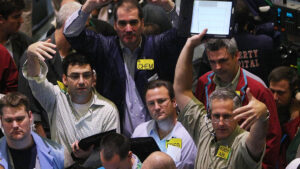This Sydney-based exchange platform is operating at the forefront of the global trading landscape

(Getty Images)
For Australian tech business MarketGrid Systems, the next six months could have some exciting developments in store.
Founded in 2011, the company has built up a globally diverse client base with matching engine technology — an automated trading platform that helps facilitate high-speed transactions.
But for the team behind it, their experience in exchange technology dates back a lot further — to the late 1980s.
That’s when current CEO Paul Phillips built and developed one of the world’s first electronic matching engines for the Singapore stock exchange.
A few years later, Phillips and Rob Hodgkinson, MarketGrid’s director of business development, built out a similar software product, which shortly thereafter was rolled out on the Shanghai stock exchange.
Suddenly, their technology was in demand. The pair set up a company — Financial Market Software Consultants (FMSC) — and began fielding requests from different exchanges across the globe looking to update their technology.
A few years later, FMSC had a global staff of 120 people, and Phillips and Hodgkinson subsequently sold the business to share registry company Computershare (ASX: CPU) — now an $8.6bn mainstay on the ASX200.
Fast forward to 2011, in a post financial-crisis world where technology advances were driving a rapid pace of change around clearing and settlement, as well as high-frequency trading software.
It was in that environment that Phillips set up MarketGrid, as a vehicle to leverage those technological gains and offer an improved product to the market. Hodgkinson joined three years later as Head of Business Development, and the company has been steadily growing since.
Speaking with Stockhead, Hodgkinson provided some details on how the team took 40 years of experience in exchange technology and applied it to the current landscape.
“It was more of a clean slate rebuild. We looked at computer technology, and it had progressed a lot since the 1990s. Now you’ve got multi-threads and multi-processors which are very fast, and almost infinite memory in machines,” Hodgkinson said.
“Everything you can do on a disk you can do on memory, so the opportunity for in-memory matching is greatly scaled. And if you can multi-thread that, then your stuff can run brilliantly fast, and that’s what we did with MarketGrid.
(In computing terms, multi-threading refers to the ability of the central processing unit to execute more than one instruction concurrently).
Just like the early 1990s, business has grown fast. The company client base now includes a number of trading exchanges across multiple asset classes and jurisdictions.
While there’s a steady commercial pipeline of customers and potential partnerships, Hodgkinson said the company has taken a patient approach to growth.
“We’ve got the capacity to run a smarter, leaner business — we don’t want to be 120 people again,” he said.
“Once we established a commercial product, the focus has been on steady organic growth — everything we’ve won has been word of mouth.”
“By the same token, we haven’t had to raise capital because we didn’t want to jump to 20 people — that can be fraught with danger. If you jump too early, you can destroy your business.”
Hodgkinson said any need to raise capital would most likely be in connection with new product development — such as surveillance or leveraged trading.
For now though, the company is focused on building a global customer-base for its core product; a high-speed central matching engine that can process hundreds of thousands of transactions per second.
Not bad for a small Australian company, whose leadership team happen to be a group of pioneers in automated exchange-trading technology.
“From a product standpoint, we’re low-level nuts and bolts guys and we’ve never lost that — and we’ve always been in tech,” Hodgkinson says.
“When we saw the way computers were emerging, we wanted to change everything so it was geared more towards current computing architecture, so it’s incredibly fast. And that’s what we do.”
UNLOCK INSIGHTS
Discover the untold stories of emerging ASX stocks.
Daily news and expert analysis, it's free to subscribe.
By proceeding, you confirm you understand that we handle personal information in accordance with our Privacy Policy.








